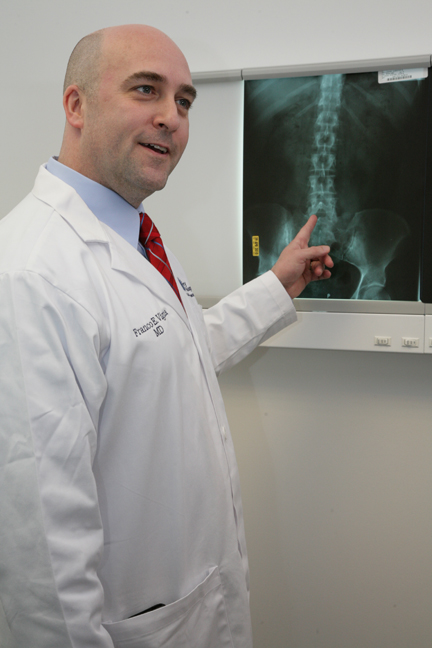PIONEER DISC REPLACEMENT SURGEON OFFERS HELP FOR BACK PAIN
By Dr. Chitra Selvaraj
 |
|---|
| Dr. Franco Vigna, one of the pioneers of disc replacement surgery |
Dr. Franco Vigna, an orthopedic spine surgeon, is one of the pioneers in the United States of artificial disc replacement surgery.
He opened up a practice in Niagara Falls around six years ago and, thanks to a strong financial commitment at Niagara Falls Memorial Medical Center, is now director of spine surgery at the hospital.
It is an intriguing story, most certainly little known in this area.
In Germany, artificial disc replacement surgery has been practiced since the 1980’s. It later became legal in Brazil.
An artificial disc replacement is indicated for people who suffer from degenerative discs (discs are cushions between the vertebrae) or injured and herniated discs in their lower spine or neck. The surgery takes out the old disc made of soft tissue and replaces it with an artificial disc made of special soft, durable plastics that cushion the movement of the spine, reduce pain, and allow greater mobility so that a person can resume normal and even vigorous activity.
In Baltimore, Dr. Vigna became involved in the experimentation of artificial disc replacement surgery during his fellowship. He was part of a pioneer team for lumbar disc replacement and neck disc replacement that hoped to prove to the FDA in three separate studies that these surgeries were efficacious. He traveled to Brazil to learn more and bring the technique back to the United States.
Through Dr. Vigna and others, the artificial disc in the low back was approved in the U.S. in 2004. So far, the disc replacement approach looks promising, according to published analysis of recent studies.
A 2011 study published in The British Medical Journal evaluated 173 spine surgery patients to compare disc replacement surgery with conservative care. The authors of the study found that those who initially had spinal fusion were twice as likely to have a revision surgery as those whose first surgery was a disc replacement.
The study authors also found that disc replacement surgery, compared to a course of rehabilitation, resulted in improved ability to cope with one’s daily tasks and activities in a significant number of the 173 participants.
Of course not every surgical candidate is best served with disc replacement.
Dr. Vigna performs the discectomy, where he removes all or part of the disc that was pushing on a nerve root causing pain or fusion operations where the doctor fuses one vertebra (bone) to another.
By far and away, spinal fusions are performed more frequently than total disc replacements for common spinal conditions such as degenerative disc disease, scoliosis and more. In a spinal fusion two adjacent bones are fused together. The biomechanics of your spine may be altered after a fusion, which, in turn, may place pressure on the adjacent joints.
The thinking behind a total disc replacement is that it preserves your spine’s ability to move. In this way, a total disc replacement surgery may help reduce the incidence of joint stresses in neighboring joints, when compared with spinal fusion.
“The goal of spine surgery is to tailor the right operation to the right patient,” said Dr. Vigna, “I have patients that have had back pain for 10 or 12 years and been to numerous physicians and they still have no idea what the problem is… They have never seen their own X-ray or MRI. We sit down with the patient, get to know them, show them their films and then come up with a treatment plan. The plan may include physical therapy, chiropractic care, injections. They may need referral to pain management or another type of treatment. Our goal is to point the patient in the right direction and treat them the best we can. If they need an operation, then the goal is to tailor that operation to the pathology we are seeing and the lifestyle of the patient.”
His work at Memorial has been aggressive.
According to Pat Bradley, director of marketing and public relations for Memorial Hospital, “A lot of people are afraid to go see a back surgeon because they think if they go to a surgeon they will have to have an operation.”
Dr. Vigna said, “I try to exhaust all non-operative treatments first. I use physical therapy, chiropractic, pain management physicians, physicians that do injections. My goal is to treat them conservatively and then, if they are not getting better or the pathology warrants it, we look at surgical intervention.”
Mr. Bradley added, “When surgery is required, we have a surgeon here who has the experience and expertise to do it and do it right and treat the patient the best.”
Dr. Vigna grew up in Connecticut. He went to college in Boston for business and worked in the financial industry for five years before realizing that high finance was not his life’s calling.
“I wanted to touch people in a way I couldn’t do in the financial industry,” Dr. Vigna said. “So I decided to go to medical school.”
He did his residency at State University of New York in Brooklyn, then went to Baltimore and worked at the Maryland Spinal Reconstructive Surgery Fellowship through Johns Hopkins. After working successfully there to help shepherd in spine disc replacement surgery in the U.S., he moved to Western New York and soon afterward opened his own practice in Niagara Falls.
“I think a good surgery can cut the pain in half and let a person get on with their lives,” Dr. Vigna said. “In some cases we take all the pain away.”
Dr. Vigna was selected for the Patients' Choice Award 2011. Of the nation's 720,000 active physicians, just 5 percent were accorded this honor in 2011.